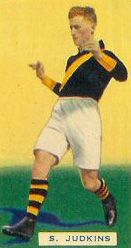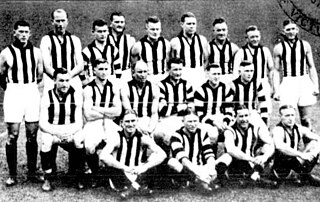Related Research Articles

The Charles Brownlow Trophy, better known as the Brownlow Medal, is awarded to the Best and fairest player in the Australian Football League (AFL) during the home-and-away season, as determined by votes cast by the four officiating field umpires after each game. It is the most prestigious award for individual players in the AFL. It is also widely acknowledged as the highest individual honour in the sport of Australian rules football.

Haydn William Bunton was an Australian rules footballer who represented Fitzroy in the Victorian Football League (VFL), Subiaco in the West Australian Football League (WAFL), and Port Adelaide in the South Australian National Football League (SANFL) during the 1930s and 1940s.
Gregory Donald Williams is a former Australian rules footballer who represented Geelong, the Sydney Swans and Carlton in the Australian Football League (AFL) during the 1980s and 1990s. A midfielder, he is a dual Brownlow Medal winner and at his peak was the then-highest-paid player in the history of the sport, including an under-the-table $200,000 bonus payment. He was also linked to further controversy during the 1990s.

James Ross Bartel is a former Australian rules footballer who played for the Geelong Football Club in the Australian Football League (AFL). A utility, 1.87 m tall and weighing 89 kilograms (196 lb), Bartel contributed as a midfielder, forward, and defender.
Ian Harlow Stewart is a former Australian rules footballer who played for the St. Kilda Football Club and Richmond Football Club in the Victorian Football League (VFL). He later coached South Melbourne and Carlton before returning to St. Kilda to serve as general manager.
Harry Collier was an Australian rules footballer in the Victorian Football League.

Stan Judkins was an Australian rules footballer who played for the Richmond Football Club in the Victorian Football League between 1928 and 1936. He became the first Richmond player to win the game's most prestigious award, the Brownlow Medal.

The 1930 VFL season was the 34th season of the Victorian Football League (VFL), the highest-level senior Australian rules football competition in Victoria. The season featured twelve clubs and ran from 3 May to 11 October, comprising an 18-match home-and-away season followed by a four-week finals series featuring the top four clubs.
The 1931 VFL season was the 35th season of the Victorian Football League (VFL), the highest-level senior Australian rules football competition in Victoria. The season featured twelve clubs and ran from 2 May to 10 October, comprising an 18-match home-and-away season followed by a four-week finals series featuring the top four clubs.
The 1924 Brownlow Medal was the inaugural year the award was presented to the player adjudged the fairest and best player during the Victorian Football League (VFL) home and away season. Edward 'Carji' Greeves of the Geelong Football Club won the medal by polling seven votes during the 1924 VFL season.
The 1977 Brownlow Medal was the 50th year the award was presented to the player adjudged the fairest and best player during the Victorian Football League (VFL) home and away season. Graham Teasdale of the South Melbourne Football Club won the medal by polling fifty-nine votes during the 1977 VFL season. The count was the second of two occasions in which the two field umpires independently voted for the best players on the ground under the 3-2-1 system. This meant that the winner of the Brownlow had a higher number of votes than usual, and Teasdale's fifty-nine votes set and holds the record for the most votes ever polled in a single season. From 1978 onwards, the field umpires conferred after each game and awarded a single set of votes, rather than voting independently.
The 1990 Brownlow Medal was the 63rd year the award was presented to the player adjudged the fairest and best player during the Australian Football League (AFL) home and away season. Tony Liberatore of the Footscray Football Club won the medal by polling eighteen votes during the 1990 AFL season.
The 1930 Brownlow Medal was the seventh year the award was presented to the player adjudged the fairest and best player during the Victorian Football League (VFL) home and away season. The award was won jointly by Stan Judkins of the Richmond Football Club, Harry Collier of the Collingwood Football Club, and Allan Hopkins of the Footscray Football Club. It was the first time more than one player won the award in the same year.
The 1981 Brownlow Medal was the 54th year the award was presented to the player adjudged the fairest and best player during the Victorian Football League (VFL) home and away season. Bernie Quinlan of the Fitzroy Football Club and Barry Round of the South Melbourne Football Club both won the medal by polling twenty-two votes during the 1981 VFL season.
The 1940 Brownlow Medal was the 17th year the award was presented to the player adjudged the fairest and best player during the Victorian Football League (VFL) home and away season. Des Fothergill of the Collingwood Football Club and Herbie Matthews of the South Melbourne Football Club both won the medal by polling thirty-two votes during the 1940 VFL season.
The 1949 Brownlow Medal was the 22nd year the award was presented to the player adjudged the fairest and best player during the Victorian Football League (VFL) home and away season. Colin Austen of the Hawthorn Football Club and Ron Clegg of the South Melbourne Football Club both won the medal by polling twenty-three votes during the 1949 VFL season.
The 1952 Brownlow Medal was the 25th year the award was presented to the player adjudged the fairest and best player during the Victorian Football League (VFL) home and away season. Bill Hutchison of the Essendon Football Club and Roy Wright of the Richmond Football Club both won the medal by polling twenty-one votes during the 1952 VFL season.
The 1959 Brownlow Medal was the 32nd year the award was presented to the player adjudged the fairest and best player during the Victorian Football League (VFL) home and away season. Bob Skilton of the South Melbourne Football Club and Verdun Howell of the St Kilda Football Club both won the medal by polling twenty votes during the 1959 VFL season.
The 1965 Brownlow Medal was the 38th year the award was presented to the player adjudged the fairest and best player during the Victorian Football League (VFL) home and away season. Noel Teasdale of the North Melbourne Football Club and Ian Stewart of the St Kilda Football Club both won the medal by polling twenty votes during the 1965 VFL season.
References
- ↑ Lovett, Michael, ed. (2009). AFL Record Season Guide 2009. Docklands, Victoria: Slattery Media Group. p. 496. ISBN 978-0-9805162-6-5.
- ↑ "1931 Brownlow Medal" . Retrieved 3 November 2016.
- ↑ "League Football - Premiership Rounds". The Argus. Melbourne, VIC. 25 April 1931. p. 20.